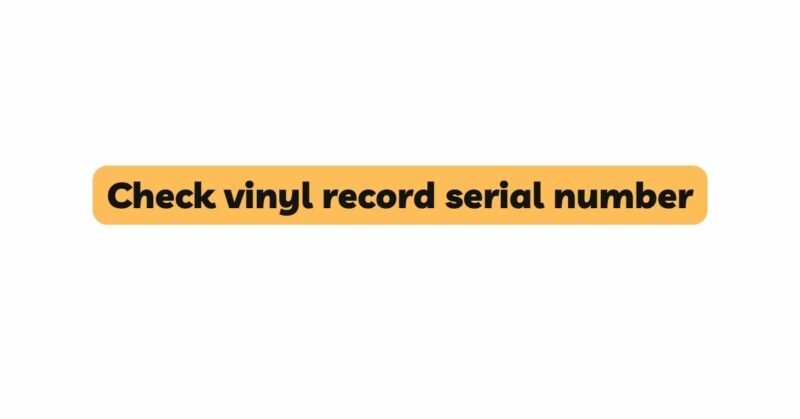Vinyl records possess a timeless allure, not only for the music they carry but also for the mysteries etched into their grooves. Among these enigmas is the serial number—an alphanumeric code imprinted on the record’s run-out groove. The serial number contains a treasure trove of information, from the record’s origin and pressing plant to its production year and more. This article embarks on a journey of discovery, guiding collectors and enthusiasts on how to check and decode vinyl record serial numbers to unveil the hidden stories within.
The Anatomy of Vinyl Record Serial Numbers
Serial numbers on vinyl records are more than just arbitrary sequences of letters and numbers. They encode essential details about the record’s manufacturing, making them invaluable tools for understanding its history and provenance. These serial numbers are typically located on the label, the run-out groove area, or both. With careful observation and research, collectors can decipher the meanings behind these codes.
The Pressing Plant Code: Tracing Origins
The first segment of a vinyl record’s serial number often reveals the pressing plant where it was manufactured. Different pressing plants employed unique codes to identify themselves, serving as a stamp of origin for the record. By referencing databases and collector resources that catalog these codes, enthusiasts can trace the record’s journey from the plant to their collection. Identifying the pressing plant provides insights into production standards, quality, and even potential sound variations.
The Production Year: Time Travel Through Codes
A significant piece of information embedded within the serial number is the production year of the record. Some serial numbers incorporate the year directly, while others include codes that savvy collectors can decipher using reference guides. Decoding the production year offers a glimpse into the record’s vintage, providing a valuable context for understanding its historical significance and the cultural landscape at the time of its creation.
Mastering the Matrix Numbers: Deeper Insights
The matrix numbers etched into the run-out groove area offer a deeper level of insight into a record’s origins. These numbers serve as a cataloging system used by pressing plants to track master plates, production batches, and more. By cross-referencing matrix numbers with online databases, reference books, and collector forums, enthusiasts can uncover a wealth of information, including mastering engineers, pressing dates, and even potential reissues.
Decoding Label Specifics: Labels Hold Clues
Labels often have unique codes, symbols, or variations that collectors can decode to gain additional context about a record’s pressing. These might include label color variants, logos, or typography changes that correspond to different years or pressing plants. Collectors can consult label-specific resources and online databases to decipher these codes and refine their understanding of the record’s origin and vintage.
Collectors’ Collaborative Efforts: Community Wisdom
The pursuit of decoding vinyl record serial numbers benefits from the wisdom and shared experiences of collector communities. Online forums, social media groups, and specialized websites dedicated to vinyl record collecting provide platforms for enthusiasts to collaborate and seek guidance. By engaging with these communities, collectors can seek advice, share their findings, and learn from the experiences of those who have delved into the intricacies of serial number decoding.
Archival Resources and Reference Books
For collectors seeking comprehensive and accurate information, archival resources and reference books are essential tools. These sources often compile data on label variations, pressing plant codes, and historical context, offering a comprehensive guide to decoding serial numbers. Publications authored by experts and seasoned collectors provide detailed insights and act as valuable companions in the quest for deciphering vinyl record serial numbers.
Practical Steps to Check Vinyl Record Serial Numbers
- Inspect the Label: Examine the label on the vinyl record for any alphanumeric sequences. Look for codes etched into the run-out groove area, which often provide vital clues.
- Research Plant Codes: Research pressing plant codes using online databases and collector resources. Identify the pressing plant that corresponds to the code found in the serial number.
- Decode the Year: If the serial number includes a year code, use reference guides to translate it into a production year.
- Consult Matrix Numbers: Observe the matrix numbers in the run-out groove area. Cross-reference these numbers with databases, forums, and resources to uncover production details.
- Examine Label Variations: Study label variations, including color, logos, and typography. Decode any label-specific codes to refine your understanding of the record’s origin.
- Engage with Collectors: Join online collector communities to seek advice, share findings, and learn from the experiences of others in the pursuit of decoding serial numbers.
- Refer to Reference Books: Consult archival resources and reference books authored by experts in vinyl record collecting. These publications offer comprehensive insights into decoding serial numbers.
Conclusion
Checking and decoding vinyl record serial numbers is a captivating journey that connects collectors and enthusiasts to the history, origins, and hidden stories within their records. The alphanumeric codes etched onto these sonic relics offer windows into pressing plants, production years, and even mastering details. As collectors unlock the mysteries behind these codes, they breathe life into their vinyl collections, forging a deeper connection to the music, the artists, and the historical context in which the records were created.

